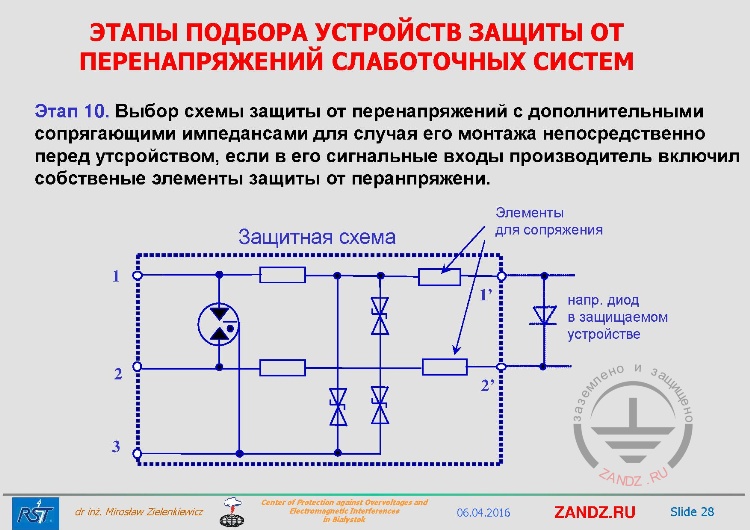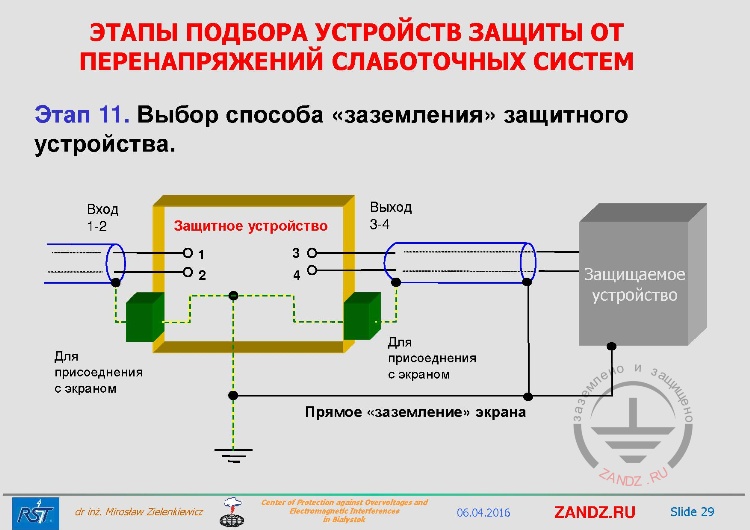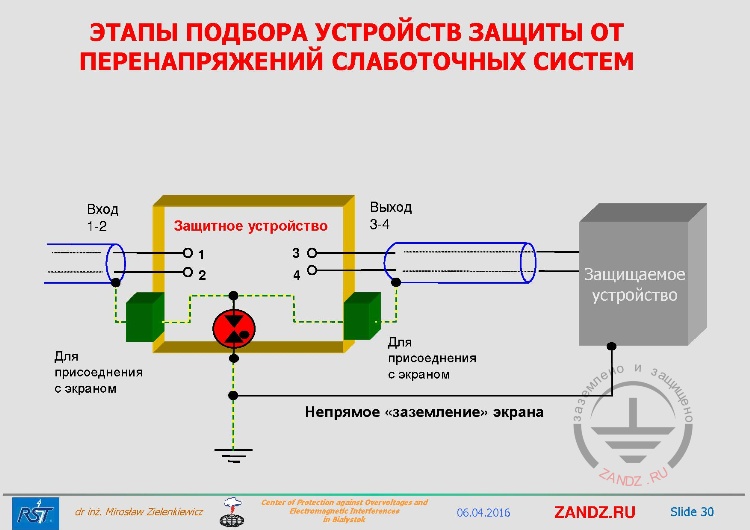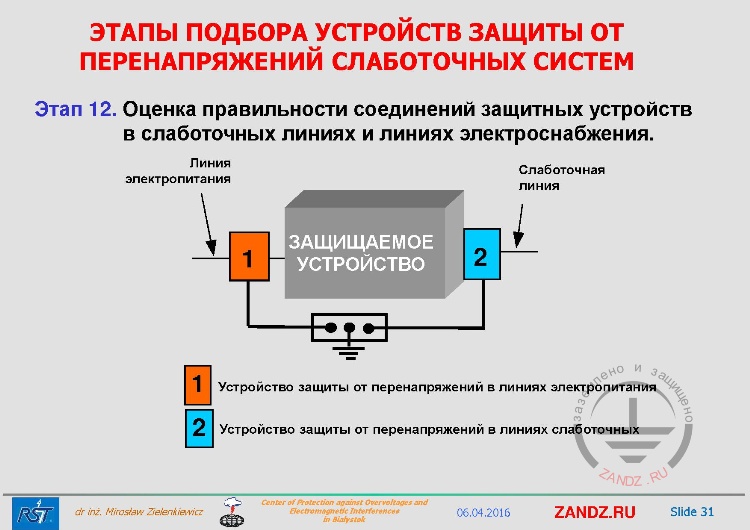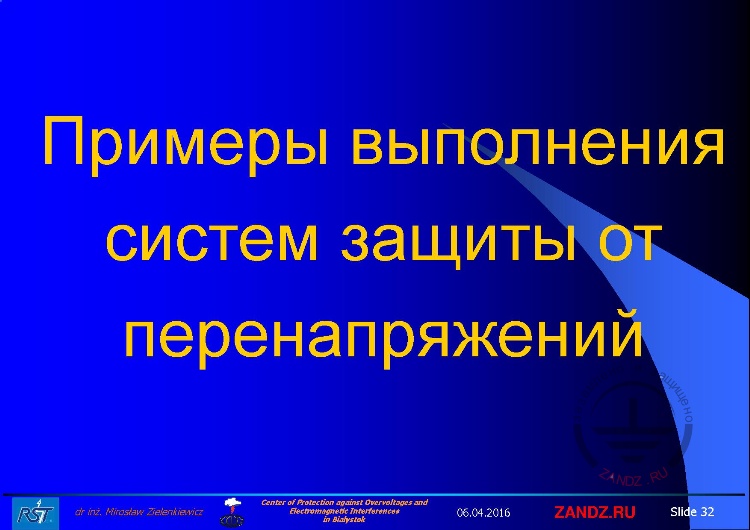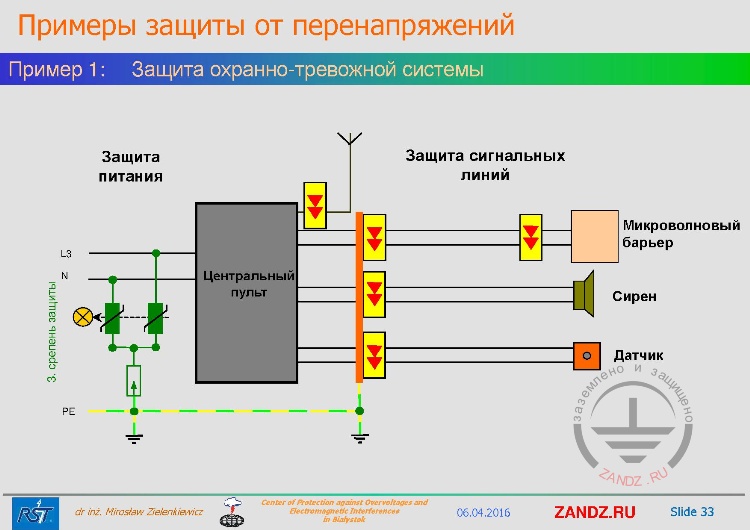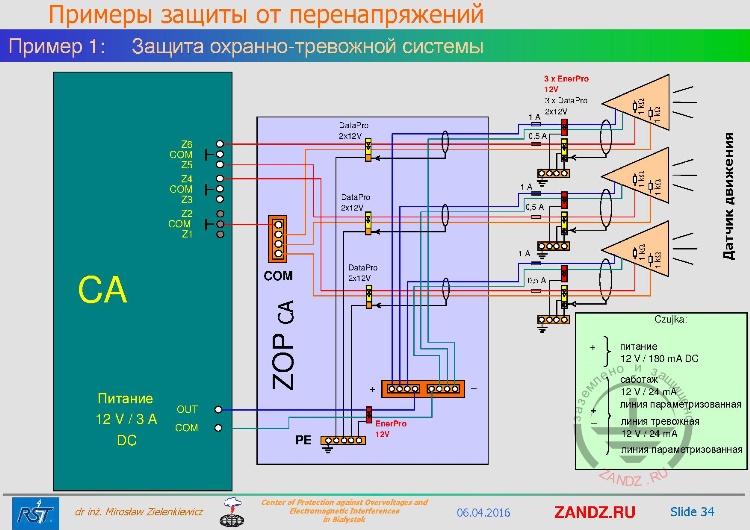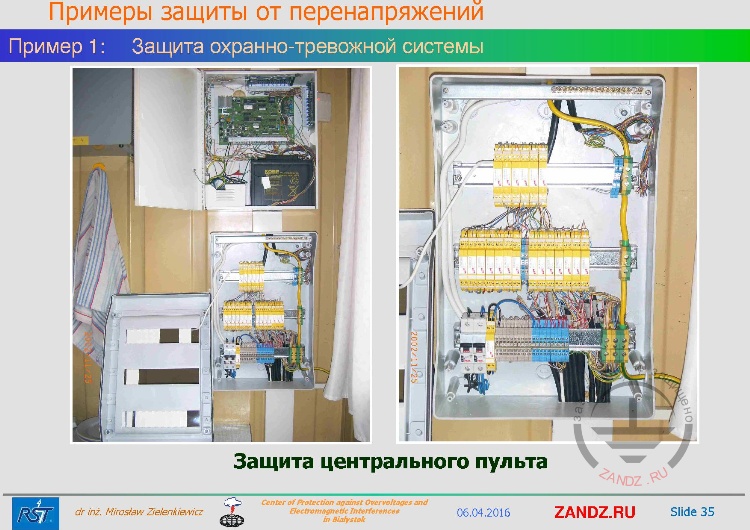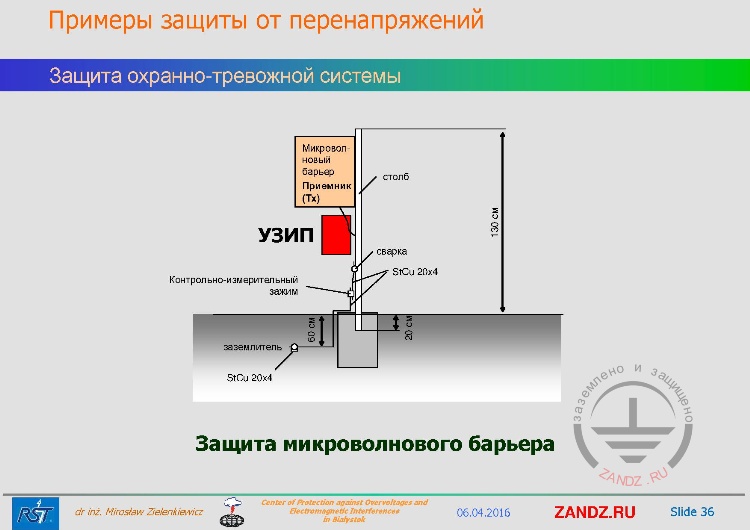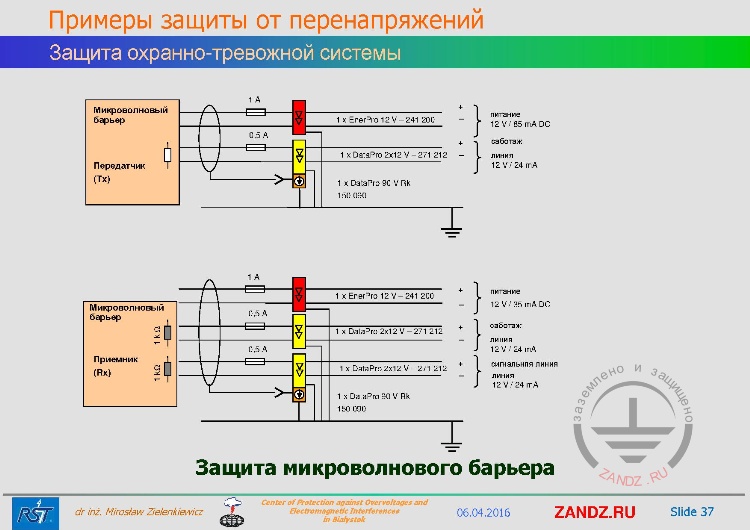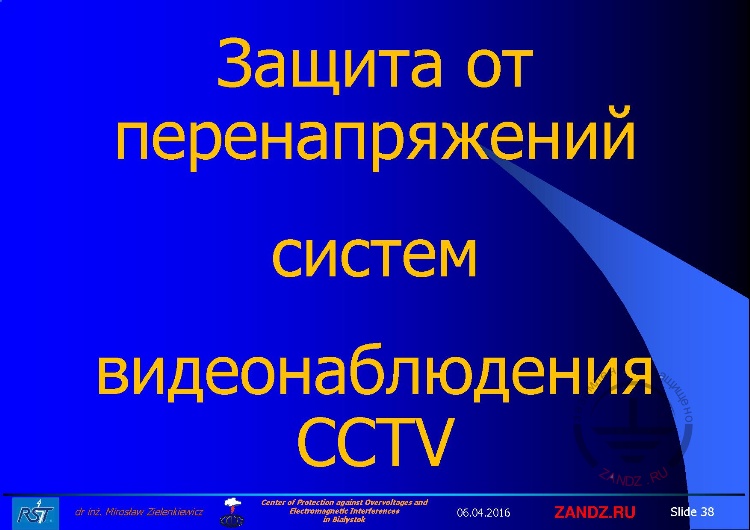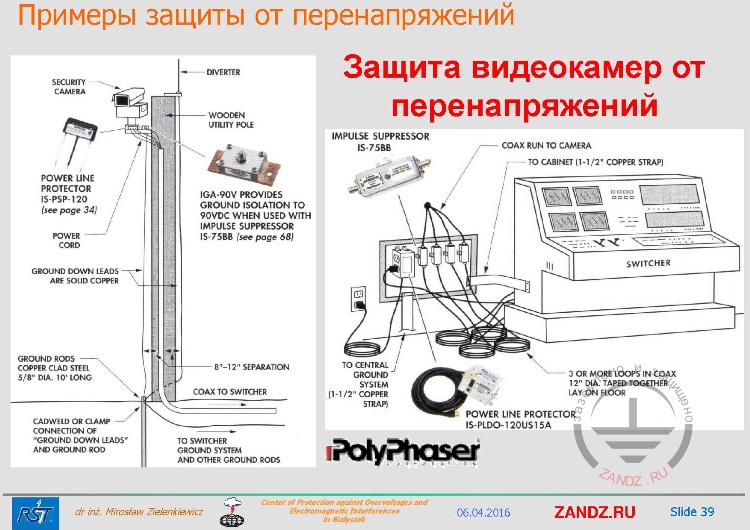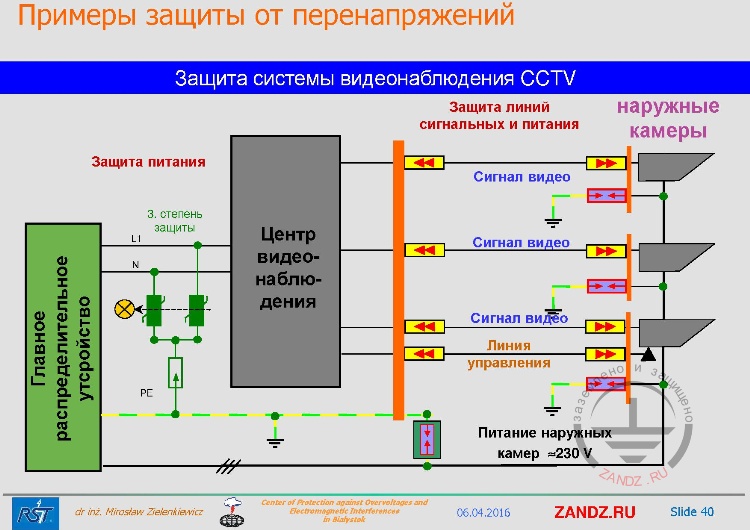The 4th webinar about Surge Protection
Webinar text. Page 3
Quick slide navigation:
1. Rules of surge suppressors selection
2. About Miroslaw Zielenkiewicz
3. Lightning Electromagnetic Pulse Protection
4. Thunderstorm Electromagnetic Pulse Protection
5. Electromagnetic environment (IEC 50155)
6. Protected device with surge suppressor
7. Object geometry
8. Surge suppressor at the cable entry of the object
9. Two-stage protection system of signalling link
10. Stage 1. Determination of device stability
11. Example for railway devices
12. Table of port stability
13. Stage 2. Master data definition
14. Basic technical data of the electronic system
15. Differential and longitudinal interference
16. Wave impedance of signalling link
17. Stages 3 and 4 of protection devices selection
18. Gas-filled arrester
19. Energy Distribution of Surge Arrester
20. Multi-stage circuits
21. State standard IEC 61643-21-2014
22. Stage 5. Determination of the number of protective degrees
23. Stage 6. Determination of maximum allowable voltages
24. Stage 7. Determination of the method of signal transmission
25. Stage 8. Determination of the maximum signal voltage
26. Stage 9. Determination of the nominal frequency of operating signals
Page 3:
27. Stage 10. Selection of surge protection circuit
28. Stage 11. The choice of the method of grounding the device
29. Indirect grounding of the screen
30. Stage 12. Estimation of device connections
31. Examples of surge protection
32. Security and alarm system protection
33. Layout of security elements
34. Protection of the central point
35. Microwave barrier protection
36. Protection circuit of the microwave barrier
37. CCTV security protection
38. Surge protection of the video cameras
39. Protection circuit of the CCTV security
40. Protection of a video camera
41. Protection circuit of the CCTV
42. Surge protection of multiplexer
43. SPDs for the protection of the CCTV
44. Light pole with video camera
45. Protection circuit of the RST-safe CCTV
46. Installation manual of the arrester in the shield
47. 75 Ohm video signal lines
48. RST-safe CCTV
49. Example of the video camera protection on the roof
50. Surge protection of sports facilities
51. Football stadium, 2004
52. Loudspeaker outriggers
53. Surge protection shield
54. Operation of protecion elements
55. Light indicator as a fault signalling
56. Surge protection of extensive systems
57. Surge protection of perimeter security
58. Perimeter protective belt
59. Cable laying under the ground
60. Perimeter protection of alarm system
61. Example of the object - tower
62. Microwave barrier
63. Examples of internal device protection
64. Protection circuit of the alarm system board
65. Final protection circuit without primary protection
Stage 10. Selection of surge protection circuit
| ЭТАПЫ ПОДБОРА УСТРОЙСТВ ЗАЩИТЫ ОТ ПЕРЕНАПРЯЖЕНИЙ СЛАБОТОЧНЫХ СИСТЕМ | STAGES TO CHOOSE SURGE PROTECTION DEVICES FOR LOW-CURRENT SYSTEMS |
| Этап 10. Выбор схемы защиты от перенапряжений с дополнительными сопрягающими импедансами для случая его монтажа непосредственно перед утсройством, если в его сигнальные входы производитель включил собственые элементы защиты от перанпряжени | Stage 10. The selection of overvoltage protection circuit with additional padding impedances for the case of its installation right before the device, if the manufacturer has included its own protection elements against overvoltage in its signal inputs |
| Защитная схема | Protective circuit |
| Элементы для сопряжения | Elements for coupling |
| напр. диод в защищаемом устройстве | for example, diode in the protected device |
— And as a result, we are coming to the conclusion that we need to select the voltage of the currents and the frequency range specifically. And if we are not sure that the device does not have special surge protection. And manufacturers have the right to install it to meet the requirements of standards for electromagnetic compatilbility. One of which is for the railroad I have shown you before. And, for example, he installed it on purpose, because his system could not withstand shocks of 1, 2 kV, in some cases they can be 4 kV. He installed at the cable entry special elements that allowed him to fulfill the requirements of these standards.
Stage 11. The choice of the method of grounding the protective device
| ЭТАПЫ ПОДБОРА УСТРОЙСТВ ЗАЩИТЫ ОТ ПЕРЕНАПРЯЖЕНИЙ СЛАБОТОЧНЫХ СИСТЕМ | STAGES TO CHOOSE SURGE PROTECTION DEVICES FOR LOW-CURRENT SYSTEMS |
| Этап 11. Выбор способа «заземления» защитного устройства | Stage 11. The choice of the protective device grounding method |
| Вход | Input |
| Выход | Output |
| Защитное устройство | Protective device |
| Защищаемое устройство | Protected device |
| Для присоеднения с экраном | For screening |
| Прямое «заземление» экрана | Direct grounding of the screen |
— In practice, the question always comes up, what to do with the cable screen? Today, everybody who knows about an outdoor cable in an object with the lightning protection system, if it is not screened, it can carry tremendous energy. Therefore, all external cables must be screened. And what to do with the screen? If you remember studying at the university, if you remember your technical work experience, we have met different approaches to cable screens. First, screen in order to be a screen, the screen must divert the currents induced in it to the ground. Simply put, it must be grounded. The question which side is grounded is always very interesting. I always say that whichever side they taught you at school is the side to ground the screen. But it all started from signal standards when we had analog systems. There has always been a problem with interference that went through the screen when we would ground it in places where large short-circuit currents flowed through ground, for example. Today we deal with his problem better. And from our point of view on overvoltage protection, it would be good to ground the screen in one centimeter steps. Just kidding.
Indirect grounding of the screen
| Непрямое «заземление» экрана | Indirect grounding of the screen |
— Therefore, in this case, we additionally insert a spark arrester. Its limiting pulse voltage will be about 500-700 V. I call this indirect grounding of the screen that will work only when necessary. And then the designer or the manufacturer of this system cannot prohibit us to install such element, because in this emergency mode, when high voltage appears here, it will be suppressed by our element. The current that attempts to flow through the screen into the object will be closed at the cable entry of the object to the ground.
Stage 12. Estimation of device connections
| ЭТАПЫ ПОДБОРА УСТРОЙСТВ ЗАЩИТЫ ОТ ПЕРЕНАПРЯЖЕНИЙ СЛАБОТОЧНЫХ СИСТЕМ | STAGES TO CHOOSE SURGE PROTECTION DEVICES FOR LOW-CURRENT SYSTEMS |
| Этап 12. Оценка правильности соединений защитных устройств в слаботочных линиях и линиях электроснабжения | Stage 12. Estimation of protective device connections in low-current lines and power supply lines |
| Линия электропитания | Power supply line |
| Слаботочная линия | Low-current line |
| ЗАЩИЩАЕМОЕ УСТРОЙСТВО | PROTECTED DEVICE |
| Устройство защиты от перенапряжений в линиях электропитания | Power supply lines surge protection device |
| Устройство защиты от перенапряжений в линиях слаботочных | Low-current lines surge protection device |
— The second question is always: how to install SPDs protection elements in the power supply network and low-current lines. I think that after we talked about the zone protection concept, it was clear to everyone that these elements should not be intstalled far from each other, but in the same shield where we place all surge protection devices. These shields happen to be very big. Then we must always fight to ensure that these distances are not bigger than 0.5 meters, because the voltage drop across the inductor when these currents the reverse currents leak to the ground will be too high. We install them in the same shield at the entry to this zone and at the entry to this protected device, for example, at the bottom of the protected device shield, but everything is still in the shield. I will show it later. We must install a special metal structure to shield the reverse current that go to the ground and those that come from our sensitive device outside.
— Let me try to read Dmitrii's question: "Is there a necessity (for the stability) to lay shielded communication cables (data transmission) in metal sleeves/pipes along a metal tower (lightning conductor) and in the ground or is it enough to install it on a cable run laid from the tower to protect overvoltage limiter?" The question is not that simple to answer without a figure. I am afraid that without a special figure I can not explain this to you.
Examples of surge protection
| Примеры выполнения систем защиты от перенапряжений | Examples of surge protection |
— Let's continue. I want to show you on practical examples of how surge protection is actually implemented and what logic is actually applied.
Security and alarm system protection
| Пример 1: Защита охранно-тревожной системы | Example 1: Security and alarm system protection |
| Защита питания | Power supply protection |
| Защита сигнальных линий | Protection of signaling lines |
| Центральный пульт | Central control desk |
| 3. степень защиты | 3. protection class |
| Микроволновый барьер | Microwave barrier |
| Сирен | Siren |
| Датчик | Sensor |
— We all understand that it is possible to weld a very serious high-level tool at any point of our system. Question: how will it end? I'm afraid that from time to time by a nuclear explosion, pardon my humour. And in this case, the zone protection concept about which we have already spoken many times, makes it easier for us to protect and reduces overall designing time. Here we see an example of a low-current system, a securite and alarm system. The system, and when it is the alarm system, is characterized, as we have already said, by a very large number of lines that go from the central point to point A. From statistics, this means that a large interference can come to one of the lines and it can damage or simply change the working conditions of our system. In this case, at the cable entry to the object, all the wires are protected from the leaking overvoltage. If the cores are free, then we close to the electrical bonding bus that is always connected to the ground at the one-storey building. And if it is inside the object, then inside the equalization system that is usually indicated by yellow and green colours. So, this bus is always connected in this place at one point from the power supply side and from all signal lines. And at one point we divert this energy to the ground. Let's agree for now that we are talking about external systems that are outside the object. The same for antenna cable. At the cable entry to the object, not at the central control desk, we install overvoltage protection. Now, our friend in Warsaw was building an antenna system on a 100 meter object in the center of Warsaw. And imagine that there is protection installed inside the object a hundred meters down the cable. You have to understand that when lightning strikes this cable, this current will flow to the protection element and somehow this current will be diverted to the ground inside the object. Maybe it will go back to the roof, if someone designs it this way, or down. So all this energy inside this cable chamber will interfere with other cables. In other words, he can protect his device, but damage the other ones. So, all the elements are at the cable entry to the object. And what do we do with the elements that give signal to our system?
Layout of security elements
| Питание | Power Supply |
| Датчик движения | Motion detector |
| саботаж | sabotage |
| линия параметризованная | parametrized line |
| линия тревожная | alarm line |
— We have some central point. At the entry cable we install SPD. We call it ZOP, this is our local name. Everyone, please, look at all the screens. Protection is installed. It is connected at the cable entry to one common bus. Here are the names of the "LEUTRON" elements that we will talk about at the next webinar. Individual elements have been selected everywhere. Every sensor is protected locally. And it can be seen here that the special surge protection element comes additionally from the screen. Here it shown, excuse me, Czujka, it is a sensor. One power signal has 12 V and 180 mA DC. And we must choose the one that will work in these conditions. The sabotage line is protected separately. The alarm line is protected separately. We have to separately review all the lines and select such parameters of the protection elements so that we did not suppress the signal or introduce interference.
Protection of the central point
| Защита центрального пульта | Protection of the central control desk |
— And so, it turns out that at the cable entry to the object all signal wires are protected in one SPD. They are connected to the common bus that comes in on top of the cable. The grounding goes in the same direction, so that the energy of these cables did not leak further and we did not let the object this energy. And the already laid protected cores go to the central point of the alarm system.
Microwave barrier protection
| Микроволновый барьер | Microwave barrier |
| Приёмник | Current-using equipment |
| УЗИП | SPD |
| Контрольно-измерительный зажим | Control-and-measuring terminal |
| столб | column |
| сварка | welding |
| заземлитель | grounding switch |
| Защита микроволнового барьера | Microwave barrier protection |
— When we deal with microwave barriers, we must always remember that they do not have great resistance. And such microwave barriers are often installed at very long distances, on very long object perimeters. Cables have the length of 100 meters and more, so there is always an SPD at the receiver or transmitter of such system. ground protection is Always installed there locally.
— There was another question from Sergei Kalenov: "Miroslaw, did I understand right that is best to install the protection device at the cable entry to the building?" Yes, Sergei. It is not better, but the protection device always must be installed at the cable entry to the building. If you watch the first webinar on the zone concept of lightning protection, then we discussed it there. A protection device that is at the cable entry and at the borders of the next zone inside the object.
Protection circuit of the microwave barrier
| Микроволновый барьер | Microwave barrier |
| Приёмник | Current-using equipment |
| питание | Power Supply |
| саботаж | sabotage |
| сигнальная линия | signal line |
| линия | line |
| Защита микроволнового барьера | Microwave barrier protection |
— If we analyze such microwave barrier, in practice we have to study its scheme, what signal output standards are. We select those elements for them that we see on the right. "EnerPro" for 12 V, "DataPro" for 90 V is already a spark gap. And we see that there are fuses of 1 and 0.5 A, these are our devices. Therefore, our elements must be able to pass such currents in the nominal mode, as indicated here. All lines are protected, take a look at the power supply and sabotage. Sabotage also includes cores, they will pass high potential as well. If we do not protect these cores, then again we will not have complete protection.
CCTV security protection
| Защита от перенапряжений систем видеонаблюдения CCTV | Surge protection of CCTV security |
— Let's look at the system that gives us a very good income for more than 15 years. This is a surveillance system called CCTV in the West.
Surge protection of the video cameras
| Защита видеокамер от перенапряжений | Surge protection of the video cameras |
— An example from the American company called "PolyPhaser", with which we have been cooperating for many years. It works mainly in coaxial lines. Here we see that many years ago for the cable point we installed protection at the camera and at the cable entry where the conductors are laid to the dispatcher, to the central observation point.
Protection circuit of the CCTV security
| Защита системы видеонаблюдения CCTV | CCTV security protection |
| Защита питания | Power supply protection |
| Главное распределительное устройство | Main switchgear |
| 3. степень защиты | 3. Protection rating |
| Центр видеонаблюдения | CCTV center |
| Защита линий сигнальных и питания | Protection of signaling lines and power supply lines |
| Наружные камеры | Outside cameras |
| Сигнал видео | Video signal |
| Линия управления | Control line |
| Питание наружных камер ~ 230 V | Power supply of outside cameras ~ 230 V |
— Therefore, we protect all external cores. Which cores? Video signal, power supply in each camera and control line, if the camera is controlled. We do not miss any core at the cable entry in the building. And in this case with cameras, they are very sensitive. And the same is repeated for each camera. And here the practical question rises immediately: how to get the cables to these cameras in the object? For example, we can pass the power in this camera in many places, for each camera in separate points. And at every point we have to install overvoltage protection from the power supply network.
<< Previous page
slides from 14 to 26
Next page >>
slides from 40 to 52
Useful materials for designers:
- Webinars with leading industry experts
- Everything for calculations of grounding and lightning protection
- Useful materials: articles, recommendations, examples
Related Articles:


